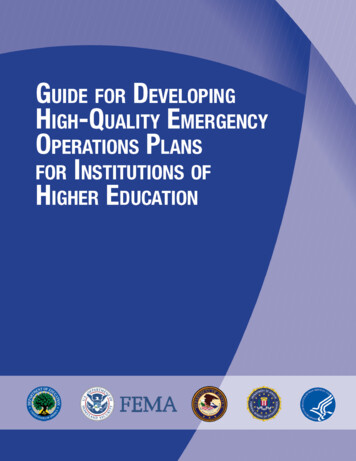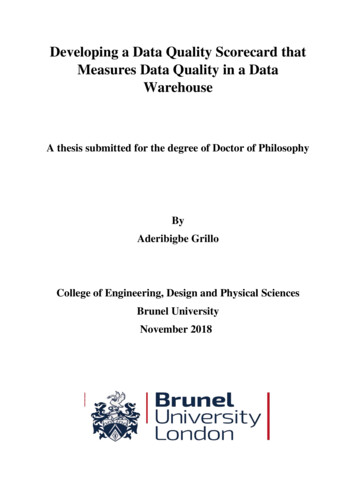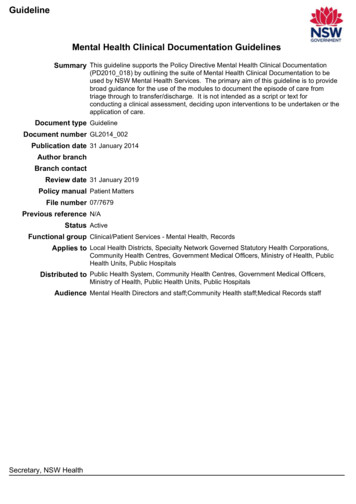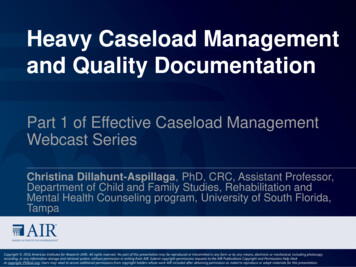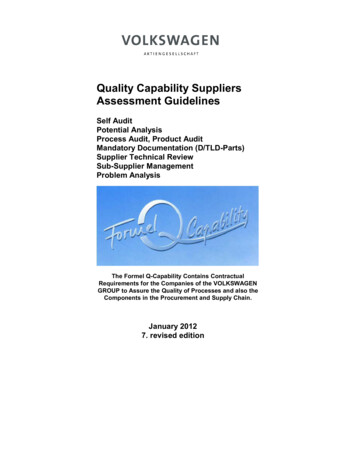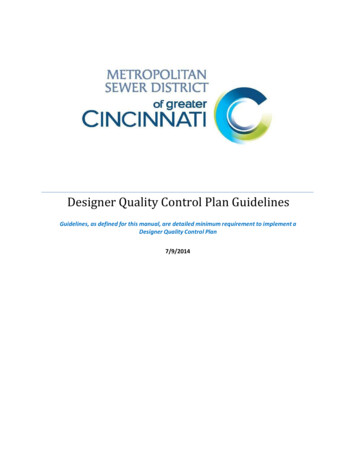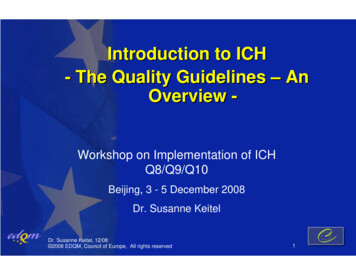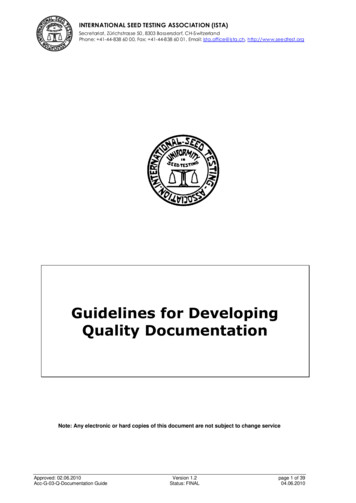
Transcription
INTERNATIONAL SEED TESTING ASSOCIATION (ISTA)Secretariat, Zürichstrasse 50, 8303 Bassersdorf, CH-SwitzerlandPhone: 41-44-838 60 00, Fax: 41-44-838 60 01, Email: ista.office@ista.ch, http://www.seedtest.orgGuidelines for DevelopingQuality DocumentationNote: Any electronic or hard copies of this document are not subject to change serviceApproved: 02.06.2010Acc-G-03-Q-Documentation GuideVersion 1.2Status: FINALpage 1 of 3904.06.2010
Guidelines for Developing Quality DocumentationA. INTRODUCTIONThis document provides guidance for the development, preparation and control of quality manualstailored to the specific needs of the user. The resultant quality manuals should reflect documentedquality system procedures required by the ISTA Accreditation Standard. Examples are used to showone or several possibilities how requirements of the ISTA Accreditation Standard may be consideredappropriately. All these examples originate from existing laboratory quality manuals; for confidentialityreasons references to the laboratories have been deleted. Another purpose of these examples is toshow the great variety of possible solutions and to demonstrate that what may be appropriate for onelaboratory does not necessarily represent the best solution for another one. This should encouragelaboratories in finding suitable, customized solutions reflecting the laboratory‟s daily work. Thisdocument is considered to be a guideline and may not be complete as the continual improvementapproach is assumed.B. STRUCTURE AND FORMAT OF QUALITY MANUALSThe Q-documentation consists of at least the following three levels or parts also referred to asDocument Hierarchy:I.Quality Manual (Q-Manual) annexes or appendices (comprising approximately 10-30 pages)The purpose of a Q-Manual is to outline the general policies and procedures for staff, customers,accreditation bodies and/or legal bodies to provide an overview of the laboratory‟s quality system.II.Documented quality system procedures such as Standard Operating Procedures (SOPs)Standard Operating Procedures describe standard procedures in a concise manner to providesufficient information to carry out the work concerned. The volume depends on the size of thelaboratory, number of tests, number and qualification of staff and kind of equipment in use.III. Other quality documents such as working instructions, forms, reportsWorking instructions give details on the standard procedure concerned. This may be e.g. speciesrelated information on a specific test method. Forms, checklists, reports related to a standardprocedure should be provided where appropriate. Working instructions or specimen forms may bedirectly attached to the respective SOP if applicable.Describes the quality system in accordance with the stated qualitypolicy and objectives and the accreditation standardQ-Manual(Level A)Describes the activities of individual functional unitsDocumented quality system procedures(standard operating procedures SOPs)(Level B)Consists of detailed work documentsOther quality documents(work instructions, forms, reports, etc.)(Level C)There is no required structure or format for quality manuals, however, it should convey accurately,completely and concisely the quality policy, objectives and governing documented procedures of thelaboratory. Each solution has its advantages and disadvantages.Book/booklet:Advantage: easy control of distributed copiesApproved: 02.06.2010Acc-G-03-Q-Documentation GuideVersion 1.2Status: FINALpage 2 of 3904.06.2010
Disadvantage: revisions of existing documents requires replacement of the whole document andall its copiesRing binder:Advantage: revisions of existing documents by replacing single pages/chapters or entire SOPs,less time and cost consumingDisadvantage: it may be more difficult to control distributed copies. A thorough document changeservice needs to be establishedIt is recommended to use a flexible system like ring binders since changes often occur, ideallysupplemented by an intranet component. It has to be noted that the following principles have to beapplied accordingly to computerised systems.Cover-sheet of the Q-Document chaptersThis page should give minimum information such as laboratory‟s name and contact details, name ofdocument, indication of approval (“approved by: “), copy number, i.e. a unique number for eachcontrolled copy and - if applicable, an indication “controlled document” – “uncontrolled document”. Therationale behind this is to facilitate identification and control of all the single elements forming the Qdocumentation (Example 1).C. HOW TO START WITH THE PREPARATION OF A Q-MANUAL?The process of establishing a quality assurance system documentation should begin with appointmentof the coordination task to a management-delegated competent body, which may be an individual or agroup of individuals. The appointee or the group of appointees is responsible for the following tasks: to obtain data on the actual state of the quality assurance system to plan the documentation system to collect and compile existing documentation and require additional documentation wherenecessary to review the documentation to ensure clarity, suitability and proper structure to develop a distribution policy to incorporate pertinent changes to act as contact person/s in all matters of the quality assurance systemD. THE Q-MANUALQ-manuals may be developed and used by an organisation for purposes including, but not limited tothe following: communicating the laboratory‟s quality policy, procedures and requirements describing the quality system providing documented bases for auditing quality systems providing continuity of the quality system and its requirements during changing circumstances training personnel in the quality system requirements and methods of compliance presenting the quality system for external purposes, such as demonstrating compliance withrespective accreditation standardE. WHAT TO INCLUDE IN A QUALITY MANUAL?1. Scope and field of applicationIn the scope or field of application it shall be clearly stated for which activities/departments of thelaboratory the Quality Manual is valid.2. Table of contents (indicating title of chapters/sections and subchapters/subsections)Approved: 02.06.2010Acc-G-03-Q-Documentation GuideVersion 1.2Status: FINALpage 3 of 3904.06.2010
The numbering or coding system of sections, subsections, pages, figures, exhibits, diagrams,tables, working sheets, etc., should be clear and logical3. Definitions and explanation of laboratory specific abbreviations4. Policy and Quality Objectives4.1.In this section, intentions and objective targets of the laboratory incl. a statement that theseed testing laboratory‟s standard of service will be in accordance with the requirements ofthe ISTA Accreditation Standard and the current version of the ISTA Rules (Example 2)(Example 3) are stated. It should also describe how the quality policy is made known to, andunderstood by, all employees and how it is implemented and maintained at all levels. NOTE:A description of the activities of the laboratory is not a substitute for the Q-policy statement.4.2.Based on the Quality Policy, Quality Objectives shall be determined. Objectives shall bequantifiable (current value, target value, time period) to facilitate a target/actual valuecomparison (Example 4). The Q-objectives need not necessarily to be included in the Qmanual; a mere reference to the document where they are to be found, for instance anannual plan, would be sufficient. Determination and verification of achievement of theobjectives is to be made at least annually in the management review, see below or in otherrelevant planning documents.5. Description of the Q-System and the Document Control Procedure5.1.Explanation of the structure of the Q-documentation, e.g. how many levels, what kind ofdocuments are used (Q-Manual, SOPs, if applicable work instructions (WI), forms, log books,checklists, loose sheet copies, etc.). The description should ensure that somebody using thedocument understands the way it is to be used (Example 5).5.2.There should be a description of the document identification system (e.g. “SOP 01” or “SOPA01”, e.g. “A” stands for Administration, or “F1” for the form number 1).5.3.Purpose of document control procedures is to guarantee that each page of the Qdocumentation is identifiable and attributable. Document issue and change control areessential to ensure that the content of the quality documentation is properly authorized. Thedocument control system defines who and in which way suggestions for changes in thedocuments can be made, who decides on necessary amendments and the time frame whenchanges are due. It is recommended to create a form where suggestions/revisions are notedand brought to the attention of the person responsible for the revision (Example 6)5.4.Each page of the Q-documentation should at least contain (Example 7): Name of the document Page number: It is recommended to number the pages of each QM-chapter or SOPseparately rather than numbering the pages consecutively for the whole document. Theformat must be as “page X of Y” instead of only “page X” Revision status Version number (or “valid since date”) Control indication such as „This is a controlled document“ or „This document is notsubject to change service“.5.5.A description should also be given about how external documents are controlled (e.g. ISTARules, ISTA Laboratory Accreditation Standard).5.6.The distribution concept outlines the addressees/recipients for controlled or uncontrolledcopies of the document. If documents are distributed electronically or by mail, explanationmust be given on how the laboratory ensures that the new versions were received. This maybe done by listing the documents on a master list of controlled documents (or documentmatrix) (Example 8).A master list of controlled documents should at least contain the following: name of the document (and document code) version number of current document approval date recipients (can be person(s) and/or a place, e.g. room number)Approved: 02.06.2010Acc-G-03-Q-Documentation GuideVersion 1.2Status: FINALpage 4 of 3904.06.2010
person responsible for distribution of new or revised documents6. Organisation and Management6.1.Description of the organization, responsibilities and authorities: In this section the laboratoryshould provide a description of the high-level structure of the organisation. This may bepreferably made by an organisational chart, where responsibilities, authorities andinterrelationship structure are included (Example 9). It puts the laboratory and sampling unitin the overall context within a larger organisation, e.g. the institute within the ministry ofagriculture, or the seed testing laboratory unit within a seed company, and the organisationalstructure within the laboratory (Example 10) to define and show sections/departments (staffadministration, financial department, how sampling is linked to the laboratory), functions orpositions, (technical manager, quality manager), sample reception/registration, testingsections, issuance of ISTA Certificates.6.2.Independence of judgement and integrity in relation to sampling and seed testing activities:The laboratory must describe how it meets these requirements of the ISTA AccreditationStandard (more especially paragraph 3.5 of the ISTA Accreditation Standard, Version 5.0,2007).6.3.Defining the responsibility of the management, i.e. providing resources (human and financialresources), determining the Q-policy and Q-aims, management review, promoting qualityassurance system to increase awareness, motivation and involvement.7. Staff and Training7.1.Description of responsibilities and authorisations of laboratory functions and positions (e.g.head of the laboratory, technical manager, quality manager, supervisors, technicians/analysts, administrative personnel, trainees, etc.)7.2.Laboratory staff matrix showing responsibilities and deputies in key activities (Example 11).7.3.Description of the general policy concerning internal and external training (i.e. workshops,instruction, on-the job training, etc.). How does the laboratory management determine theindividual training needs? What are the criteria (e.g. based on annual performanceappraisals)? What is the basis to set up an annual training plan or how are training needsidentified and recorded? How is training recorded?7.4.Description of a general training procedure for new staff members. This general description issupplemented by a more detailed SOP describing the training programme for new staffmembers. (Example 12)8. Laboratory Premises8.1.In this section the laboratory premises should be described, if possible including a floor plan.If applicable, provisions taken against excessive temperatures and moisture, vibration (stablework benches and tables) should be mentioned as well as measures taken to protect the staffin terms of health and safety (e.g. testing of coated seed). A brief description how goodhousekeeping in the testing laboratory is ensured should be included.8.2.Definition of appropriate regulations for access and use of the laboratory premises by thestaff during working hours and off-time and definition how entry of persons external to thelaboratory (staff of foreign sections, clients or other visitors) is controlled and how it isensured that external persons are not left unattended in the laboratory premises.8.3.Sample storage: This section contains a description of the sample storage system (i.e.where, how, how long the samples are stored and which components of the samples, i.e.only remainder of submitted samples or with the other seeds and inert matter found, arestored), control/treatment and recording of pests and diseases, control and recording ofrelative humidity and temperature. Definition of procedures for disposal of stored samples(e.g. treated versus untreated seeds).9. Purchasing of Services and Supplies9.1.General description of the procedure for the selection and purchasing of laboratory servicesand supplies including description of records in place.9.2.Services and supplies that affect the quality of tests must be identified. Those critical services(e.g. external calibration of weights needed for the balances) and critical supplies (e.g.germination substrate, chemicals) must be checked to verify compliance prior to use.Approved: 02.06.2010Acc-G-03-Q-Documentation GuideVersion 1.2Status: FINALpage 5 of 3904.06.2010
9.3.Explanation on how and when the supplier of critical services and supplies are evaluated andhow suppliers are approved.10. Equipment and Calibration10.1.General description of maintenance, servicing, labelling and handling and repair of testingand measuring equipment. Records of maintenance, servicing and repair pertaining to eachitem of equipment may be stored with the respective item or at an appropriate place.10.2.Description of general procedures on how to deal with cases where any item of equipmenthas been subjected to overloading or mishandling or where it gives suspect results, or hasbeen shown by calibration or otherwise to be defective. General procedures include but arenot limited to, taking out of service, labelling, and advising the responsible person andprocedures to be followed to put the devices in operation again after repair (i.e. functioncheck, calibration). The laboratory must describe how it examines the effect of defectiveequipment on any previous tests, and withdraw and re-issue certificates where faulty resultsare suspected.10.3.General description of the laboratory‟s calibration programme to ensure that measurementsmade in the testing laboratory are traceable to national or international standards ofmeasurement. Reference to records kept on these measures must be provided.10.4.The testing and measuring equipment must be listed and columns with the followingspecifications should be included (Example 13): kind of equipment (e.g. balance, soil divider, calibration weight for balances) date of purchase manufacturer unique serial and/or inventory number range of measurement (e.g. thermometer: 0–70 C; balance: 0.001-50 g; moisture oven:50-230 C) and precision (e.g. sieve: 0.50 mm mesh size, working thermometer: 0.1 C) internal check or calibration interval (e.g. daily, weekly, monthly) and external calibration ifcertified reference standards of measurement (e.g. yearly, every two years) maintenance interval room number and/or location (e.g. purity section, room no. 125) reference document number (SOP, log book, user manual)11. Sampling11.1.In this section, the organisation and management of (ISTA) sampling is described, i.e. how isthe sampling integrated in the laboratory‟s organisation and management. This may besupplemented by an organizational chart.11.2.What are the provisions to ensure independence of ISTA sampling/ISTA samplers? Anexample of a declaration that there are no conflicts of interest in regards to sampling may beprovided.11.3.How are the testing laboratory and the samplers affiliated? A list of authorized/recognizedISTA samplers (name and address of ISTA sampler, authorisation number, category of ISTAsampler, specimen signature/initial) must be provided.11.4.What are the requirements to obtain and maintain formal authorisation as an ISTA sampler?This section should describe procedures and criteria how ISTA samplers are authorized andhow authorisation is maintained, i.e. initial training, refresher training, monitoring such asinternal auditing and/or check sampling; indicate frequency, scope and responsibilities oftraining and monitoring activities (SOPs of authorisation, training programme, monitoringprogramme) (Example 14).11.5.Specification of applied sampling procedures, i.e. national seed regulations and/or ISTAsampling procedures including date of the latest revision.Certified reference standards of measurement are periodically calibrated by an accredited national calibration serviceApproved: 02.06.2010Acc-G-03-Q-Documentation GuideVersion 1.2Status: FINALpage 6 of 3904.06.2010
11.6.Description of seed lot identification system to ensure that each seed sample is traceable tothe respective seed lot by a unique seed lot number.11.7.Handling of samples: A description of how the laboratory handle the sample when it isreceived has to be elaborated. The ISTA Accreditation Standard has described in detail whatis needed for safe handling of samples. This includes the unique identification, labelling,transport, storage and disposal, as well as that records must be kept on samples showingany unusual condition.12. Scope of testing12.1.This section specifies the scope of testing to distinguish between ISTA and non-ISTA tests.Applied test methods, i.e. national seed regulations and/or ISTA test methods including dateof their latest revision should be specified.12.2.Definition of scope of ISTA Accreditation:The specification must allow the seed analyst and interested parties to identify the species Xtest combination the laboratory is accredited for and consequently is entitled to issue ISTAInternational Seed Analysis Certificates. Ideally a detailed list of species with reference to theapplicable test methods is joined.12.3.Description of the policy of sub-contracting of sampling and tests being reported on ISTACertificates including a description how suitable sub-contractors are identified and monitored.If sub-contracting is not applicable a short indication that no sub-contracting for ISTApurposes is made is sufficient.13. Process management (work flows) (Example 15)13.1.Work flow of all relevant laboratory procedures and tests can be depicted, preferably bymeans of flow charts to show sequentially the single steps from sample entry to reporting ofresults on the certificate.14. Recording and Archiving14.1.Description of the records used and completed by samplers and laboratory staff, i.e. samplingapplication form, sampling report, laboratory work car
documentation is identifiable and attributable. Document issue and change control are essential to ensure that the content of the quality documentation is properly authorized. The document control system de


